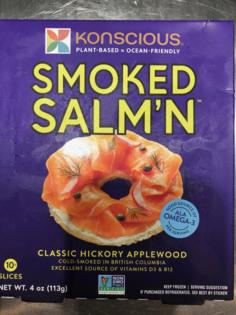What goes into fake fish, and how does it taste?
Published in Variety Menu
My poor wife cannot eat fish. Shellfish is fine, but she has an intolerance to fish that swim.
It’s actually an intolerance to a specific protein in the muscle that allows fish to propel themselves through the water, and it’s more common than you might think — especially because you probably just heard about it for the first time now.
But she likes fish, or at least she did while she could still eat it. And she likes — or liked — lox on bagels. So she did the next best thing, possibly. She bought a package of smoked fake lox made from plants.
It’s called Smoked Salm’n, and it’s made by a company called Konscious. I realize that they can’t use the word “salmon” to describe a product that has no fish in it. But spelling “Konscious” that way?
It unkonscionable.
But let’s get to the product itself. What is it made of if it isn’t made of fish?
So I looked at the ingredients. Oh dear.
The first ingredient, which is listed by weight, is water. Nothing wrong with that, even if it is unexpected. You’d think plant-based fake fish would have some sort of plant as the first ingredient. But still, it’s nothing worth writing home about.
The next ingredient is expeller-pressed canola oil, which turns out to be much less disgusting than it sounds. Canola oil is made from rapeseed, usually by using chemical solvents somehow to extract it. Expeller-pressed oil, however, is made the way you think oil is made, by using pressure to force the oil out of the seed.
No chemicals are involved. All in all, it’s a good thing.
Next up is konjac, which is something else I had to look up. Konjac is a plant that is native to China, and is sometimes used in Asian cooking. It is also known as devil’s tongue, snake palm and voodoo lily, which is probably why it is listed in the ingredients as konjac.
Konjac is also botanically related to the corpse flower. So there’s that.
Pea protein comes next. It is extracted from yellow and green split peas through a process that is longer and more complex than seems likely for something as small and easily overlooked as peas.
Carrots are next, and I’m good with that. I like carrots. And I’m also good with sea salt, which is the next ingredient.
Next up is the common thickener xanthan gum, which is created when sugar is fermented by a bacterium called Xanthomonas campestris. An alcohol is then added, turning the fermented goo into a solid, which is in turn pulverized into a powder. It’s generally benign, but people with certain gastrointestinal issues should probably avoid it.
Organic sugar cane counters the bitterness from some of the other ingredients. Pea hull fiber is added, too, which has the benefit of using the part of the pea that wasn’t touched while extracting all that pea protein.
After rice flour and something called DHA Algal oil comes natural flavors. This worries me. They can’t use the natural flavor of fish, so they must use the natural flavor of other items that, when combined, sort of taste like fish.
Among the remaining ingredients are sodium carbonate, calcium carbonate, paprika oleoresin and lycopene, which the listing of ingredients helpfully explains comes from tomatoes.
So, how does it taste? When you put all of these diverse non-fish ingredients together in a product that physically resembles smoked salmon, what does it all taste like?
Surprisingly, it tastes pretty close to smoked salmon.
But only at first.
After a second or two, a touch of bitterness begins to creep into the generally sweet flavor of salmon, and then it lingers there. The bitterness turns into a strong chemical taste burning into the side of the tongue that crowds out any of the flavor of lox and remains there for several minutes.
I finally got rid of the aftertaste by eating a piece of bread. After the bread flavor dissipated, the burning chemical taste returned.
My wife, desperate for something that tastes like fish, still wants to try it. I already feel sorry for her.
©2025 STLtoday.com. Distributed by Tribune Content Agency, LLC.










Comments